Chinese New Year poker card games
Chinese New Year gatherings are that one time a year many of us get to catch up with relatives. But after some 365 days of not seeing them, we might have to face the dreaded small talk to get through the festivities. Thankfully, poker card games can always easily solve this conundrum.
Competition is always a great way to break any ice, so here are eight poker card games to keep everyone entertained, instead of racking your brain for how to siam questions about your love life.
Table of Contents
Is it legal to gamble at home in Singapore?
Yes, under the Gambling Control Act, social gambling in the privacy of your own home with friends and family is permitted.
What’s not allowed is running a gambling den where:
- The host earns a cut or commission.
- Participants win additional prize money apart from whatever’s in the betting pool (e.g. cash prize for participating).
- Strangers are invited to play.
- The gambling takes place in a public space, including HDB void decks, hotels and chalets, dining establishments, event spaces, and community centres.
If in doubt, choose to gamble at home or with cash prize alternatives, such as with tokens or points just to keep track of who’s won.
Gambling can become a problem when it is no longer a casual recreational activity, but an addiction that brings harm to families and communities. If you or someone you know is facing a gambling problem, you may seek counselling by calling the National Council on Problem Gambling at 1800 666 8668.
What do I need to play CNY poker card games?
Just a standard deck of poker cards, which you probably already have lying around the house. This will have 4 suits of 13 cards each: Heart (red), Diamond (red), Club (black), Spade (black). A pack of cards usually includes 2 joker cards as well, which you may or may not use, depending on house rules of the games you’re playing.
To keep track of how much everyone is winning – or losing – you’ll need poker chips in various colours so you can assign values to them.
Get poker cards and poker chips on Amazon.
Common terms in poker card games
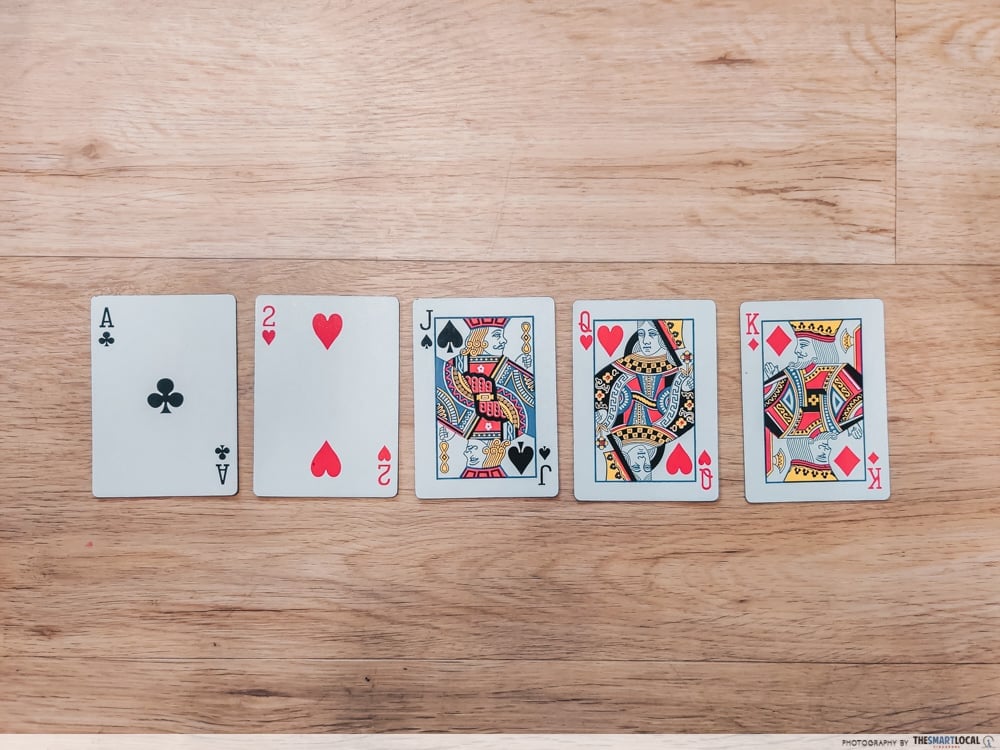
(Rank) of (suit): The ace of clubs, two of hearts, jack of spades, queen of hearts and king of diamonds.
Before you start, here are some common terms you’ll hear while playing, especially if you’re a card game newbie:
- Rank refers to the card’s “number” itself, i.e. 2-10, jack, queen, king, and ace.
- Value refers to the numeric value given to a card. For example, an ace can be worth 1 or 11 in Blackjack.
- A suit refers to one of the 4 categories – or shapes – that a card belongs to, i.e. diamonds, clubs, hearts, and spades.
- To call is to place a bet by matching the previous amount placed by another player.
- To raise is to place a bet that is higher than the previous amount placed by another player.
- To check is to maintain the original bet amount. If you previously raised a bet, you’ll be the last player to check.
- To fold is to end a turn without placing any bets.
1. Go Fish
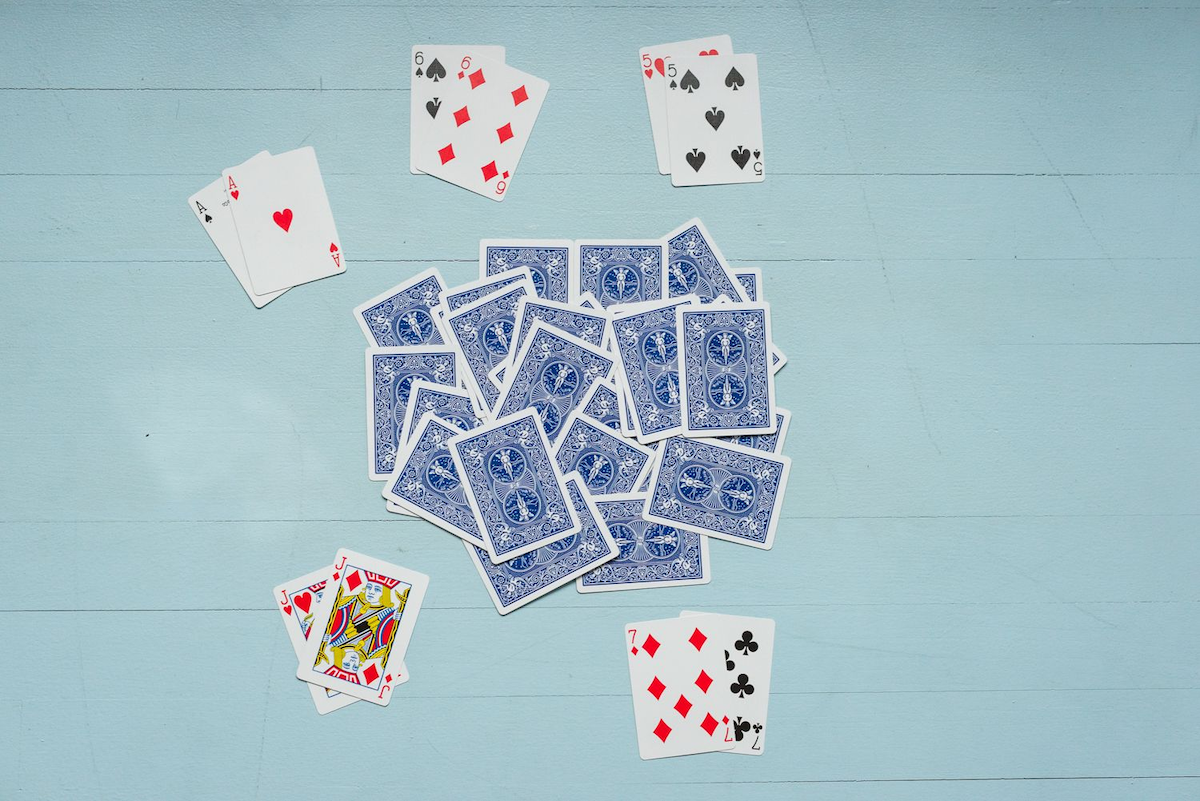
Image credit: The Spruce Crafts
We all have that one blur sotong friend in the group – try teaching them Poker and you may start tearing up. Luckily, Go Fish would be your go-to card game as it is a simple one that even kids can pick up in a jiffy.
Difficulty score: 2/10
Number of players: 2 and up
Go Fish set up: 5-7 cards per player with the remaining cards in a “pond” in the middle of the table.
How to play Go Fish: One player asks anyone in the circle for any rank they already have in their hand. For example, if they have a queen of hearts, they may ask an opponent if they have any queens. They’ll then have to give you all the queens they have. If not, they can tell you to “go fish” and you’ll have to pick up a card from the pond. The game ends when a player runs out of cards or the pond empties.
How to win Go Fish: Match sets of 4 same rank to form a “book”. The player with the most books wins.
2. Old Maid
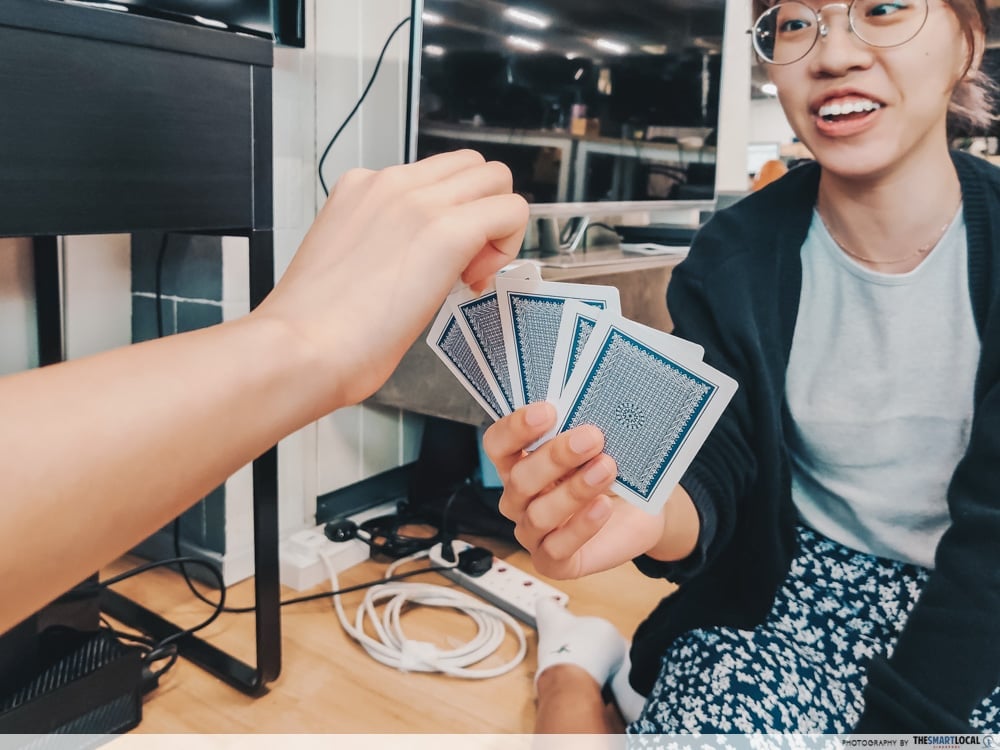
Another game about matching cards, Old Maid requires players to pair cards of the same rank and pick out a random card from the previous player to form more pairs.
The twist is that there’s an odd number of queens in the deck, so you’ll have to avoid being the last player with a single queen card. For kids, it’s an easy way of teaching them how to hold a poker face – if their opponent looks happy when you hover a card, it might just be a sign you’re about to lose the game!
Difficulty score: 2/10
Number of players: 2-8
Old Maid set up: Remove 1 or 3 queens from the deck. The odd queen left is the Old Maid. Deal the rest of the cards to all the players as evenly as possible.
How to play Old Maid: Discard any pairs of the same rank from your hand. If you’ve got 3 of a kind, you’ll need to keep the extra card. When it’s your turn, the player to your left should hold up their cards – backs facing you – and let you pick a card. If the card’s rank matches another one in your hand, put down that pair. If not, add it to your hand. Then the player to your right takes a card from your hand in the same manner.
How to win Old Maid: The first person to get rid of all the cards in their hand wins. The game continues until one person is left with the last remaining queen. That person now loses and is out of the game. More rounds can continue to eliminate players until the last person standing wins.
3. High-Low
A toddler could easily play High-Low, as long as he knows how to count. It’s a quick game to easily pass the time and grow your angbao collection once you get the hang of it.
Difficulty: 2/10
Number of players: 2 and up
High-Low set up: Everyone contributes a bet amount to the pot first. Appoint a dealer who’ll then throw a card facing up at each person’s turn. You’ll make a bet amounting to as much as the pot during your turn.
High-Low card values: Cards are ranked in running order from ace to king. In some variations, the ranks go in a cycle, so an ace can also be considered higher than a king.
How to play High-Low: After the initial card has been thrown, just make a bet if the next card will have a higher or lower value.
How to win High-Low: The best part of High-Low is enforcing a no pass rule, so everyone has to make a prediction, no matter the outcome.
Most common High-Low scenarios and bet wins/losses:
- Prediction is correct: win bet amount.
- Prediction is wrong: lose bet amount.
- Card is of same rank as initial card: no win or loss of bet amount.
- If your version allows ace to be of higher rank than a king, and the initial card thrown is a king and the second card is an ace, and the prediction was ‘low’: lose double the bet amount to the pot.
4. Ninety-nine
For those who are good at quick maf, Ninety-nine would be a piece of cake. Each player takes turns to add a card into the discard pile and call out its total value before drawing a new card. And as its name suggests, the goal of the game is to ensure that the pile’s total value does not exceed 99 during your turn, or you lose!
If you’re lucky enough to have low-value cards as the pile approaches the limit of 99, you could sabo the next player too.
Difficulty score: 3/10
Number of players: 2 and up
Ninety-nine set up: Deal 3 cards per player. Place remaining cards face down in the centre of the table as a stock pile. Leave a spot empty for the discard pile. Additionally, you can also deal 3-5 poker chips per player.
Ninety-nine card values:
- 2-3 and 5-8: face value
- 4: reverses rotation of gameplay and not worth anything
- 9: passes the player’s turn and not worth anything
- 10: -10 points
- Jack and queen: 10 points
- King: brings value of discard pile to 99
How to play Ninety-nine: Throw a card into the discard pile and count the value. Replace the thrown card with another one from the stock pile. Count until the value of the discard pile reaches 99. The value of the discard pile then resets to 0 and the game continues until there are no more cards left.
How to win Ninety-nine: The player who throws a card that exceeds 99 then loses a poker chip. Once a player loses all their chips, they’ll be eliminated from the game. The last player standing wins.
5. Indian Poker

The objective of Indian Poker is simple: the player with the highest value card wins. Sounds easy, right? Not quite. Unlike most games where you’ll know what cards you have, this one amps up the suspense by letting you see everyone’s cards but your own.
Difficulty score: 3/10
Number of players: 2-8
Indian Poker set up: Deal one card face down to each player. They’ll then hold it to their foreheads without looking at their card.
How to play Indian Poker: You can see your opponent’s card so you’ll want to bluff them that they have a high or low value so they’ll place a bet. This goes around the table with players either folding, calling, or raising the bet. The betting ends when all players have called on the bet.
How to win Indian Poker: Folded players can reveal their cards once they’re out. The rest of the players will reveal their card after the betting round ends. The player with the highest value card wins the pot. The one with the lowest value card will usually have to take a shot as punishment. To prevent people from folding too early, you can also enforce a drinking rule to get them to drink as well.
6. In-between
Difficulty: 4/10
Possibly one of the easiest games to pick up and to be introduced to social gambling is In-between. All you need is to guess the value of a third card and you’ll be able to win. You can always make calculated guesses and win for the most part. But there’s also a supposed jinx where those who win the whole pot early on will lose in subsequent rounds. You’ve been warned.
Number of players: 2 and up
In-between set up: Everyone contributes a bet amount to the pot first. 2 cards are dealt to one player at a time. The dealer will then reveal a third card after a bet is made. This continues for all players.
In-between card values: Cards are ranked in running order from ace to king.
How to play In-between: When the 2 cards are dealt in front of you, you’ll have to guess whether or not the third card will have a value between both cards.
How to win In-between: Some variations of In-between allow players to pass on their turn if they don’t have confidence that the third card will have an in-between value. If they’re right, they don’t lose their bet or win anything from the pot. But if they’re wrong, they’ll lose their bet.
Most common In-between combinations and bet wins/losses:
- Third card value is in between first two cards: win bet amount.
- Third card value is not between first two cards: lose bet amount to the pot.
- Third card value equals any of the first two cards: lose double bet amount to the pot.
- First two cards are in sequence order (e.g. 5 of clubs and 6 of diamonds): lose minimum bet amount to the pot.
- First two cards are of same rank (e.g. ace of spade and ace of hearts): win double the minimum bet amount from the pot.
7. Stress
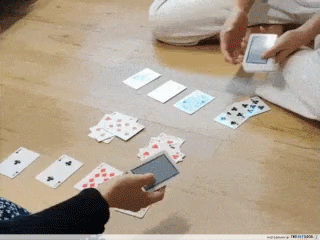
The layout of the game involves 2 central piles and 4 rows of distinct card ranks per player.
Most of us would remember playing the UNO variant of this game where having lightning-fast reaction times is key. If you don’t, Stress involves placing cards down and reacting quickly based on the rank of the cards. It is one of the most fast-paced and exciting card games that vary in difficulty depending on your opponents.
Difficulty score: 5/10
Number of players: 2
Stress set up: Split the deck of cards evenly between both players – 26 cards each. Each player should open the top 4 cards of their deck and place them on the table in front of them. If there are cards of the same rank, place them on top of each other. Each player will then open one card from their own deck into 2 discard piles in the middle of the table.
How to play Stress: Using cards from your row of 4, add to either discard pile in rank order in either direction – 5 can follow a 6 or 4, and aces come after a king. If you have a stack of same rank cards in your row, you can place both cards onto a discard pile if it’s next in rank. Replace the empty slots in your row with new cards from your deck.
If you can’t put down any cards, you’ll need to wait till your opponent can’t as well before you open a new card from the deck in your hand. You might reach a point where there are no more cards for you to overturn. When that happens, both players can close their eyes and randomly grab a card from their discard pile to use as their start card.
Watch for the cards in the discard piles. If both of you show the same card, you must be the first to yell “Stress!” and place your hand on either discard pile. Your opponent must then take the other pile and add it to their deck.
How to win Stress: Your goal is to get rid of your cards, so getting the smaller deck during Stress is important. If Stress doesn’t occur during a round, the first person to finish all the cards in their hand wins.
8. Bluff

Remember calling out your friends as kids with the phrase “liar liar, pants on fire”? Do that again with Bluff, a.k.a. Cheat or BS, where opponents are called out if you think they’re lying about the rank of their card.
Difficulty score: 5/10
Number of players: 2-6
Bluff set up: Split a deck evenly among all players.
How to play Bluff: Nominate someone to take the lead. The lead will put one card face down and call a rank. The next player then puts down a card of the same rank. This continues until all players have put down a card. If no one challenges, the stack of cards is discarded and the round starts again.
Since there are only 4 cards to each rank, it’s very possible that someone throws down a false called rank card. At any time you think that’s happening, you can call out “Bluff!” to the last player. They’ll then have to overturn the stack to show if they’ve been bluffing. If they did bluff, they must take all the cards in the stack. If they were not bluffing, then the stack goes to you and into your hand.
How to win Bluff: Be the first one to get rid of all your cards. There’s strategy involved in knowing when to bluff and when to hold back.
9. Mafia
As Singaporeans who’ve been through camps and chalet gatherings when we were younger, it’s safe to say that most of us would have played a version of this game without cards called Polar Bear, Werewolf, or Mafia. But here’s a version you can play with a deck of cards.
Difficulty score: 7/10
Number of players: 6-16 with 1 non-playing moderator
Mafia set up:
Players will be assigned a role based on the card they receive:
- Ace = Mafia (2-4 players)
- King = Sheriff (1-3 players)
- Queen = Doctor (1 player)
- Others = Civilian (0-7 players)
How to play Mafia: Everyone closes their eyes and the moderator will ask the mafia, doctor, and sheriffs to take turns opening their eyes. When these players have their eyes open they’ll choose a player to kill, save, or identify as a mafia:
Everyone then opens their eyes and the moderator will let all players know who has been killed or saved. The players will then have to collectively decide on who they think the mafia is. That player is then eliminated.
How to win Mafia: The objective of the mafia is to kill the sheriff or all players in the game without being detected. For everyone else, you win if the mafia is killed. The trick to winning is to seem the least sus as possible to your fellow players!
10. Dai Di (Big Two)

Dai Di was my introduction to poker card games when I was still in primary school. It’s a game that’s relatively easy to pick up, but knowing the best hands to throw is where skill and strategy is needed. Unlike most games where the ace or king is the highest ranking card, Dai Di sees the 2 card as the highest in gameplay.
Difficulty: 7/10
Number of players: 2 and up
Dai Di set up: Distribute a deck of cards evenly among players. In some variations, if the 52 cards cannot be split equally, any leftover cards go into a ‘pass’ pile.
Dai Di card values:
Both ranks and suits follow a specific order for Dai Dai. 3 is the smallest rank, followed by 4 till king, then ace, then 2, which is the biggest card. As for suits, the order goes diamond, club, heart, spade. Therefore, the 3 of diamonds is the smallest card, and 2 of spades is the biggest card.
How to play Dai Di: The player with the smallest card (3 of diamonds) goes first. They can choose to put down a single card or a combination such as double, triple, or group of 5. The next player must throw down a combination that is of higher standing than the previous player.
For example, if player A throws down 3 of diamonds and 3 of spades, player B cannot throw a 3 of clubs and 3 of hearts, even if he has it in his hand. He must throw a double of higher value, such as a pair of 4s with any suit. If a player doesn’t have a higher combination, they may skip their turn. If there are cards in the ‘pass’ pile, they must take one and add it to their hand.
If everyone has done a pass, the game restarts and the player who threw the last card gets to decide which card(s) to start with. For example, if player A throws a 2 of spades, they’ll automatically get to go again since no other card can be put down. He can then start the game with a triple 6 or any combination of cards in his hand.
How to win Dai Di: Your goal is to be the first to get rid of all the cards in your hand. If any betting is involved, this could mean winning the pot. In some games, the play continues and the last one to get rid of their cards will have to throw an extra chip into the pot in the next round.
If you’ve got a 2 in your hand, knowing when to throw it down is crucial. You don’t want to throw it too early or you’ll be at a disadvantage as the game progresses. You’re also not allowed to end a game with a 2 in your hand. In some cases, that calls for the player to pay the bet amount to the other players.
Here are the most common Dai Di 5-card combinations you can throw:
- Straight: 5 cards in ascending rank order, regardless of suit.
- Flush: 5 cards of any rank, but all of the same suit.
- Full house: 1 triple and 1 pair.
- 4 of a kind: 4 of any rank and 1 other card of any rank and suit.
- Straight flush: 5 cards in ascending rank order and all of the same suit.
11. Ban Luck or Blackjack
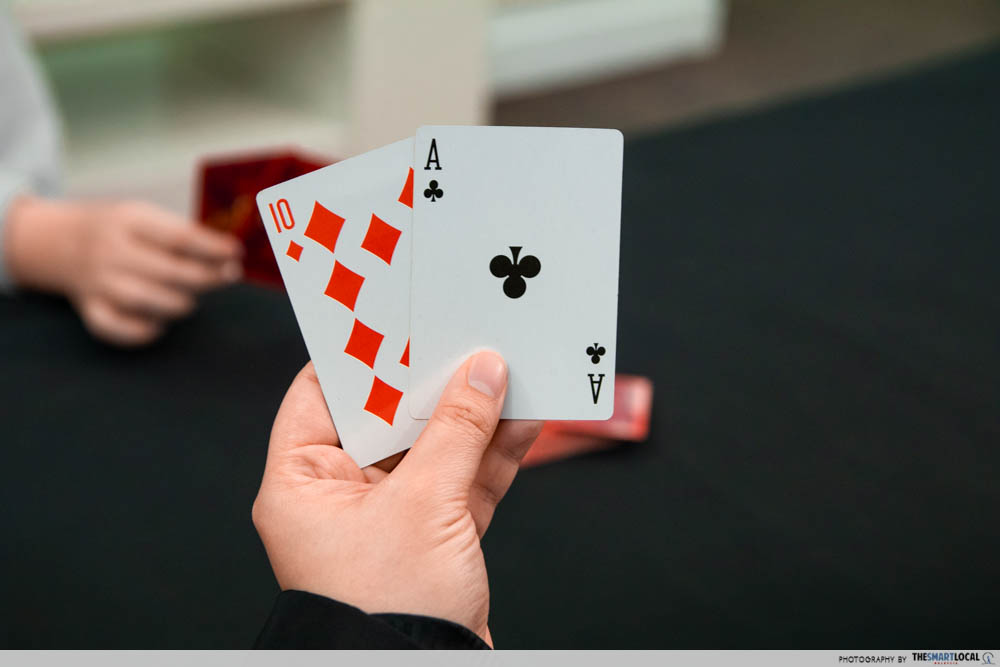
One of the most popular games you’ll see people play during CNY gatherings is Ban Luck or Blackjack. It’s another game that requires quick and calculative counting to win. In fact, you can even increase your chances of winning if you know how to count cards – i.e. the probability of getting a certain card to hit 21. If you plan on playing in casinos, just note that counting cards is almost always banned.
Difficulty score: 7/10
Number of players: 2 and up
Ban Luck set up: Nominate one person to be the banker who will deal 2 cards to each player. Everyone places a standard bet to participate.
Ban Luck card values:
- 2-10: face value
- Picture cards: 10 points
- Ace: this depends on the number of cards in your hand:
- 2 cards: 10 or 11 points
- 3 cards: 1 or 10 points
- 4 cards: 1 point
How to play Ban Luck: Both the banker and players must have at least 16 points to proceed with play. If your hand has less than 16 points, you must draw from the banker when it’s your turn. You can have a maximum of 6 cards in your hand before everyone has to show their cards.
The exception is when your first 2 cards amount to 15 points. You can then decide to fold and keep your bet.
How to win Ban Luck: The objective of the game is to hit 21 points or as close as possible without exceeding it, in as few cards as possible. However, if you have a hand of 5 that is less than 16, you lose instantly and must pay 2 times your bet amount to the banker.
The major difference between players and the banker is that players only play against the banker, so only your hand matters. The banker, on the other hand, plays against each player. For example, if player A hits 17 and the banker hits 18, player A has to pay the banker. But if player B hits 19 and player C hits 20, then the banker has to pay both players B and C.
Here are the most common Ban Luck winning combinations and bet wins:
- Ban ban: A pair of aces. Win 3 times your bet.
- Ban luck: 1 ace and either a 10 or picture card. Win 2 times your bet.
- 7-7-7: A hand of triple 7s. Win 7 times your bet.
- Dragon: A hand of 5 cards with a value more than 16 but less than 21. Win 2 times your bet.
12. Baccarat
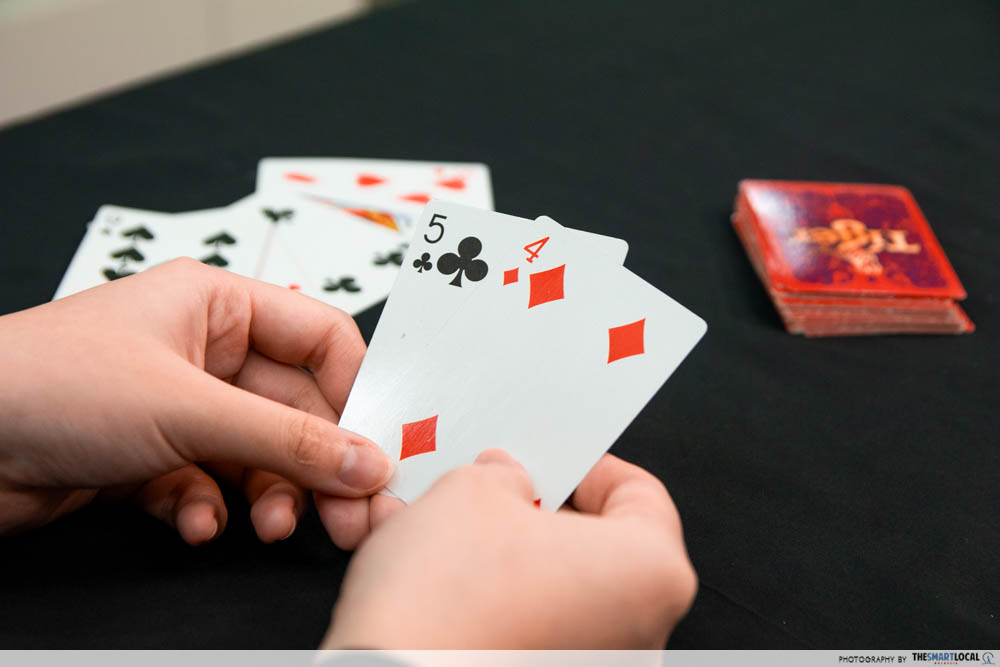
Baccarat is only complicated because you’re only looking at one digit to determine whether or not you can win your bet. Like Ban Luck, In-between, and even High-Low, you can technically count cards and make an educated guess, but there’s way more math involved. If you can calculate probabilities, then this is the game for you. If not, it’s still a fun game to host during CNY.
Difficulty: 8/10
Number of players: 2 and up
Baccarat set up: Everyone contributes a bet amount to the pot first. Then, 2 cards are dealt to everyone face up.
Baccarat card values:
- 2-9: face value
- 10 and picture cards: 0 points
- Ace: 1 point
How to play Baccarat: Calculate your total points but only look at the number in the ones position. For example, if you draw a 7 and an 8, your total would be 15, and the number you’ll need to take note of is 5.
A third card can be drawn to get your number closer to 9. All players can do this and after this round, the final numbers are tallied.
How to win Baccarat: Of course, for each round, the closest to 9 wins, and the fewer draws you need means better luck for you.
Most common Baccarat combinations and bet wins/losses:
- First 2 cards total 8 or 9: this is considered a natural, and you’ll win your bet. In some variations, you could possibly win double your bet amount.
- First 2 cards total <5: must draw a third card. If you get 8 or 9, you win your bet amount.
- First 2 cards total 6-7: you may stand and not draw a third card. If after a third card is drawn by other players and you have the highest value, you win your bet amount.
- You and dealer have same total: no win or loss of bet amount.
13. Texas Hold ‘em Poker
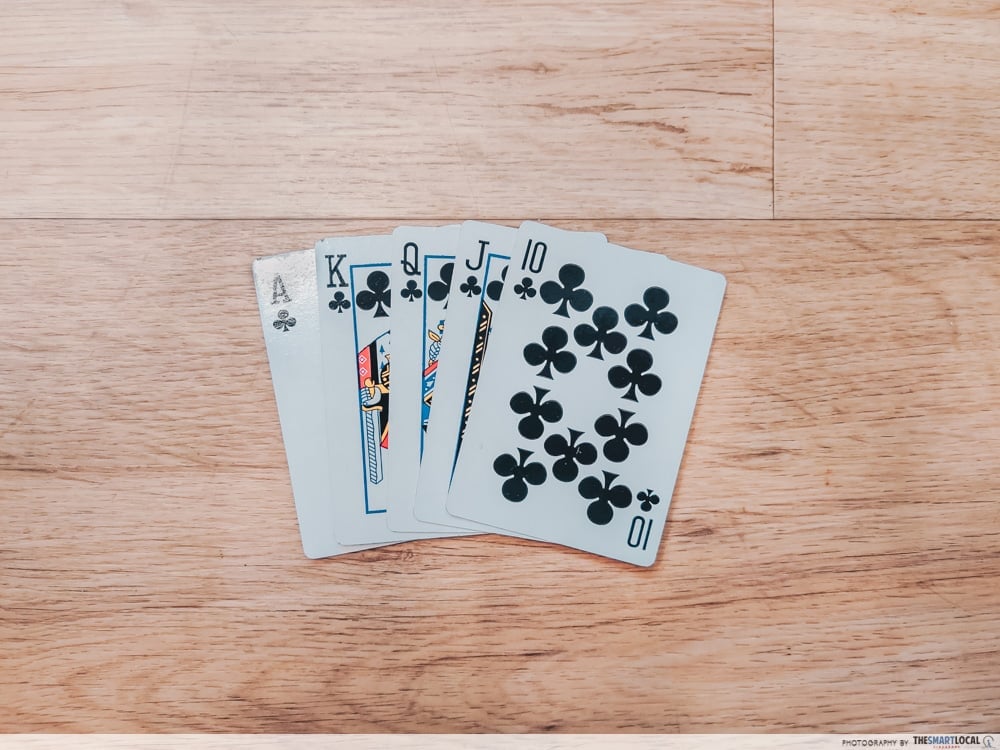
The Royal Flush, the strongest combination of cards in poker.
Texas Hold ‘em Poker is a game that involves deception, risk-taking, and memorising a huge combination of cards. Most of us would know of the term “poker face”, which is what you’ll need to master to avoid giving away how strong your hand is while tricking your opponents into taking risks.
This simplified version revolves around trying to construct the strongest poker hand. Even if you have no idea what’s going on, you can simply try bluffing your opponents and hoping none of them catch on.
Difficulty score: 9/10
Number of players: 2-8
Texas Hold’em set up: Dealer deals 2 cards face down to each player. Everyone makes a bet based on their 2 cards, after a bet is made, a card is dealt face up in the middle of the table. This is a community card. There are 5 rounds of betting where players can raise, call, check, or fold, which also means 5 community cards on the table.
Blinds can be added to a game to make them more competitive. This involves having up to 2 players, usually seated to the left of the dealer, make forced bets. Player A will make a small blind, usually half the minimum bet set by the group, while Player B will make a big blind, typically the minimum.
As more rounds take place, the setting of blinds can be shifted to other players to keep the game fair. Whenever a new community card is thrown onto the table, the players have the option to call the big blind, raise the small blind (hence tripling the small blind bet), or fold.
How to play Texas Hold’em: Each player will then build a 5-card poker hand based on the cards shown on the table. In constructing your hand, you may use a combination of any of the cards available to you, such as 2 of your own, and 3 from the table, up to all 5 from the table.
Players still in the round will then reveal their hand of 5 to each other.
How to win Texas Hold’em: Similar to the 5-card hands in Dai Di, you’ll want the strongest 5-card combo to win. Then you win the entire pot. If you fold, you get to keep your bet amount, although some variations may impose a penalty where you have to add a chip to the pot when folding.
Here are the most common Texas Hold’em 5-card combinations you can throw:
- High card: Hand includes an ace, jack, king, or queen, and any 4 cards.
- 1 pair: 1 pair of same rank, and any 3 cards.
- 2 pair: 2 pairs of same rank, and any 1 card.
- 3 of a kind: 1 triple rank and any 2 cards.
- Straight: 5 cards in ascending rank order, regardless of suit.
- Flush: 5 cards of any rank, but all of the same suit.
- Full house: 1 triple rank and 1 pair rank.
- 4 of a kind: 4 of any rank and 1 other card of any rank and suit.
- Straight flush: 5 cards in ascending rank order and all of the same suit.
- Royal flush: 10, jack, queen, king, and ace of the same suit.
Should players have matching hands, then the player with the highest rank card wins the pot. On the rare occasion that it’s equal, the pot will be split among both players.
Poker card games to enjoy with friends
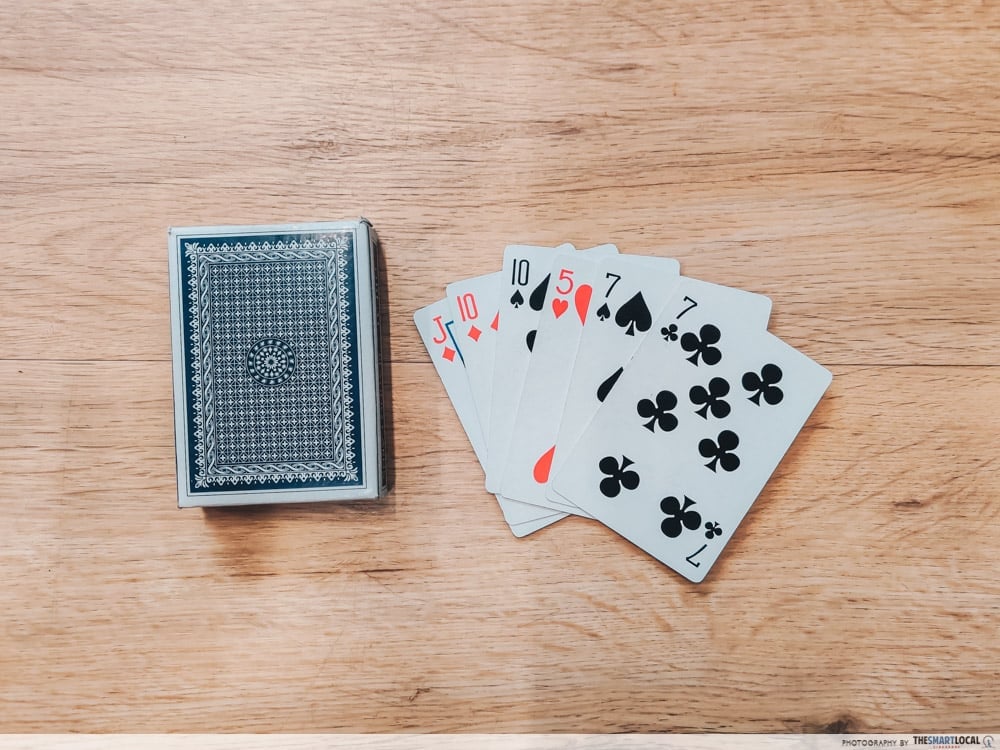
With these games of varying difficulty, you’ll now have plenty of game ideas to pick and choose from to play with your friends and family. If your new card game kakis are willing, turn these playing card games into a lifelong hobby so you’ll always have something fun to do together during gatherings.
Check out more CNY things to do:
Photography by Justin Oh and Huiwen Chan.
Last updated by Raewyn Koh on 25th January 2025.
